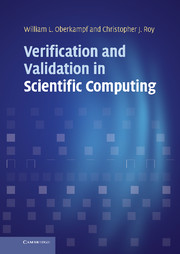Book contents
- Frontmatter
- Contents
- Preface
- Acknowledgments
- 1 Introduction
- Part I Fundamental concepts
- Part II Code verification
- Part III Solution verification
- Part IV Model validation and prediction
- Part V Planning, management, and implementation issues
- 14 Planning and prioritization in modeling and simulation
- 15 Maturity assessment of modeling and simulation
- 16 Development and responsibilities for verification, validation and uncertainty quantification
- Appendix Programming practices
- Index
- Plate Section
- References
14 - Planning and prioritization in modeling and simulation
from Part V - Planning, management, and implementation issues
Published online by Cambridge University Press: 05 March 2013
- Frontmatter
- Contents
- Preface
- Acknowledgments
- 1 Introduction
- Part I Fundamental concepts
- Part II Code verification
- Part III Solution verification
- Part IV Model validation and prediction
- Part V Planning, management, and implementation issues
- 14 Planning and prioritization in modeling and simulation
- 15 Maturity assessment of modeling and simulation
- 16 Development and responsibilities for verification, validation and uncertainty quantification
- Appendix Programming practices
- Index
- Plate Section
- References
Summary
In Chapter 2, Fundamental concepts and terminology, a summary discussion was given concerning an integrated view of verification, validation, and prediction. This chapter will discuss in detail Element 2, Planning and prioritization of activities, as shown in Figure 14.1. The topic of this chapter could be summarized as: given the wide range of activities dealing with modeling and simulation, how does one allocate resources to best achieve the goals of the project? Here, we are interested in dealing with the perspective of the management responsibilities for a large-scale, project-oriented activity as opposed to a research effort or general capability development of a commercial software package. Our discussion applies to projects within both industry and government. We emphasize engineering system projects, but the discussion also applies to the analysis of natural systems, e.g., underground storage of radioactive wastes, global climate change, and transport of contaminants or chemical agents due to atmospheric winds. The system of interest could be a new or proposed system in the design phase, an existing system that is being considered for modification or upgrade, or analysis of a system as it presently exists.
Methodology for planning and prioritization
For large-scale projects, planning and prioritization (P&P) are major activities that require a significant investment in time, money, and specialized personnel talent. Although we are primarily concerned with P&P in V&V and prediction, we comment here on the importance of P&P in large-scale projects for the development of an M&S capability. Depending on the type of organization developing the capability, it can be challenging for management to assemble the personnel with the needed talent and interest in P&P. For example, if a large-scale M&S project arrives in the midst of ongoing computational development activities, it can be difficult for management and staff to change pre-existing viewpoints, traditions and ingrained habits that are no longer appropriate, and possibly even very detrimental, to the goals of the new project. Needed changes can be particularly onerous to affect in a research or government organization.
- Type
- Chapter
- Information
- Verification and Validation in Scientific Computing , pp. 673 - 695Publisher: Cambridge University PressPrint publication year: 2010



